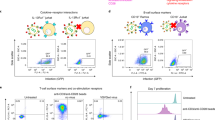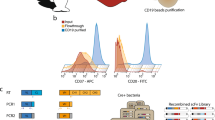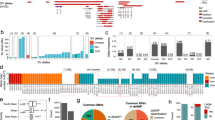Abstract
High-throughput immune repertoire sequencing has emerged as a critical step in the understanding of adaptive responses following infection or vaccination or in autoimmunity. However, determination of native antibody variable heavy-light pairs (VH-VL pairs) remains a major challenge, and no technologies exist to adequately interrogate the >1 × 106 B cells in typical specimens. We developed a low-cost, single-cell, emulsion-based technology for sequencing antibody VH-VL repertoires from >2 × 106 B cells per experiment with demonstrated pairing precision >97%. A simple flow-focusing apparatus was used to sequester single B cells into emulsion droplets containing lysis buffer and magnetic beads for mRNA capture; subsequent emulsion RT-PCR generated VH-VL amplicons for next-generation sequencing. Massive VH-VL repertoire analyses of three human donors provided new immunological insights including (i) the identity, frequency and pairing propensity of shared, or 'public', VL genes, (ii) the detection of allelic inclusion (an implicated autoimmune mechanism) in healthy individuals and (iii) the occurrence of antibodies with features, in terms of gene usage and CDR3 length, associated with broadly neutralizing antibodies to rapidly evolving viruses such as HIV-1 and influenza.
This is a preview of subscription content, access via your institution
Access options
Subscribe to this journal
Receive 12 print issues and online access
209,00 € per year
only 17,42 € per issue
Buy this article
- Purchase on SpringerLink
- Instant access to full article PDF
Prices may be subject to local taxes which are calculated during checkout




Similar content being viewed by others
Accession codes
References
Warren, E.H., Matsen, F.A. & Chou, J. High-throughput sequencing of B- and T-lymphocyte antigen receptors in hematology. Blood 122, 19–22 (2013).
Georgiou, G. et al. The promise and challenge of high-throughput sequencing of the antibody repertoire. Nat. Biotechnol. 32, 158–168 (2014).
Logan, A.C. et al. High-throughput VDJ sequencing for quantification of minimal residual disease in chronic lymphocytic leukemia and immune reconstitution assessment. Proc. Natl. Acad. Sci. USA 108, 21194–21199 (2011).
DeKosky, B.J. et al. High-throughput sequencing of the paired human immunoglobulin heavy and light chain repertoire. Nat. Biotechnol. 31, 166–169 (2013).
Sasaki, S. et al. Limited efficacy of inactivated influenza vaccine in elderly individuals is associated with decreased production of vaccine-specific antibodies. J. Clin. Invest. 121, 3109–3119 (2011).
Smith, K. et al. Rapid generation of fully human monoclonal antibodies specific to a vaccinating antigen. Nat. Protoc. 4, 372–384 (2009).
Doria-Rose, N.A. et al. Developmental pathway for potent V1V2-directed HIV-neutralizing antibodies. Nature 509, 55–62 (2014).
Wu, X. et al. Focused evolution of HIV-1 neutralizing antibodies revealed by structures and deep sequencing. Science 333, 1593–1602 (2011).
Fischer, N. Sequencing antibody repertoires: the next generation. MAbs 3, 17–20 (2011).
Wilson, P.C. & Andrews, S.F. Tools to therapeutically harness the human antibody response. Nat. Rev. Immunol. 12, 709–719 (2012).
Finn, J.A. & Crowe, J.E. Jr. Impact of new sequencing technologies on studies of the human B cell repertoire. Curr. Opin. Immunol. 25, 613–618 (2013).
Finco, O. & Rappuoli, R. Designing vaccines for the twenty-first century society. Front. Immunol. 5, 12 (2014).
Newell, E.W. & Davis, M.M. Beyond model antigens: high-dimensional methods for the analysis of antigen-specific T cells. Nat. Biotechnol. 32, 149–157 (2014).
Marcus, J.S., Anderson, W.F. & Quake, S.R. Microfluidic single-cell mRNA isolation and analysis. Anal. Chem. 78, 3084–3089 (2006).
White, A.K. et al. High-throughput microfluidic single-cell RT-qPCR. Proc. Natl. Acad. Sci. USA 108, 13999–14004 (2011).
Furutani, S., Nagai, H., Takamura, Y., Aoyama, Y. & Kubo, I. Detection of expressed gene in isolated single cells in microchambers by a novel hot cell-direct RT-PCR method. Analyst 137, 2951–2957 (2012).
Turchaninova, M.A. et al. Pairing of T-cell receptor chains via emulsion PCR. Eur. J. Immunol. 43, 2507–2515 (2013).
Berkland, C., Kim, K.K. & Pack, D.W. Fabrication of PLG microspheres with precisely controlled and monodisperse size distributions. J. Control. Release 73, 59–74 (2001).
Berkland, C., Pollauf, E., Pack, D.W. & Kim, K. Uniform double-walled polymer microspheres of controllable shell thickness. J. Control. Release 96, 101–111 (2004).
Jackson, K.J.L., Kidd, M.J., Wang, Y. & Collins, A.M. The shape of the lymphocyte receptor repertoire: lessons from the B cell receptor. Front. Immunol. 4, 263 (2013).
Jackson, K.J.L. et al. Divergent human populations show extensive shared IGK rearrangements in peripheral blood B cells. Immunogenetics 64, 3–14 (2012).
Hoi, K.H. & Ippolito, G.C. Intrinsic bias and public rearrangements in the human immunoglobulin Vλ light chain repertoire. Genes Immun. 14, 271–276 (2013).
Ippolito, G.C. et al. Antibody repertoires in humanized NOD-scid-IL2R γnull mice and human b cells reveals human-like diversification and tolerance checkpoints in the mouse. PLoS ONE 7, e35497 (2012).
Glanville, J. et al. Naive antibody gene-segment frequencies are heritable and unaltered by chronic lymphocyte ablation. Proc. Natl. Acad. Sci. USA 108, 20066–20071 (2011).
Pelanda, R. Dual immunoglobulin light chain B cells: trojan horses of autoimmunity? Curr. Opin. Immunol. 27, 53–59 (2014).
Liu, S. et al. Receptor editing can lead to allelic inclusion and development of B cells that retain antibodies reacting with high avidity autoantigens. J. Immunol. 175, 5067–5076 (2005).
Rezanka, L.J., Kenny, J.J. & Longo, D.L. Dual isotype expressing B cells [κ+/λ+] arise during the ontogeny of B cells in the bone marrow of normal nontransgenic mice. Cell. Immunol. 238, 38–48 (2005).
Casellas, R. et al. Igκ allelic inclusion is a consequence of receptor editing. J. Exp. Med. 204, 153–160 (2007).
Andrews, S.F. et al. Global analysis of B cell selection using an immunoglobulin light chain–mediated model of autoreactivity. J. Exp. Med. 210, 125–142 (2013).
Giachino, C., Padovan, E. & Lanzavecchia, A. κ+λ+ dual receptor B cells are present in the human peripheral repertoire. J. Exp. Med. 181, 1245–1250 (1995).
Corti, D. et al. A neutralizing antibody selected from plasma cells that binds to group 1 and group 2 influenza A hemagglutinins. Science 333, 850–856 (2011).
Wrammert, J. et al. Broadly cross-reactive antibodies dominate the human B cell response against 2009 pandemic H1N1 influenza virus infection. J. Exp. Med. 208, 181–193 (2011).
Jardine, J. et al. Rational HIV immunogen design to target specific germline B cell receptors. Science 340, 711–716 (2013).
Zhou, T. et al. Multidonor analysis reveals structural elements, genetic determinants, and maturation pathway for HIV-1 neutralization by VRC01-class antibodies. Immunity 39, 245–258 (2013).
Busse, C.E., Czogiel, I., Braun, P., Arndt, P.F. & Wardemann, H. Single-cell based high-throughput sequencing of full-length immunoglobulin heavy and light chain genes. Eur. J. Immunol. 44, 597–603 (2014).
Parameswaran, P. et al. Convergent antibody signatures in human dengue. Cell Host Microbe 13, 691–700 (2013).
Jackson, K.J.L. et al. Human responses to influenza vaccination show seroconversion signatures and convergent antibody rearrangements. Cell Host Microbe 16, 105–114 (2014).
Lavinder, J.J. et al. Identification and characterization of the constituent human serum antibodies elicited by vaccination. Proc. Natl. Acad. Sci. USA 111, 2259–2264 (2014).
Wine, Y. et al. Molecular deconvolution of the monoclonal antibodies that comprise the polyclonal serum response. Proc. Natl. Acad. Sci. USA 110, 2993–2998 (2013).
Boutz, D.R. et al. Proteomic identification of monoclonal antibodies from serum. Anal. Chem. 86, 4758–4766 (2014).
Recher, M. et al. IL-21 is the primary common γ chain-binding cytokine required for human B-cell differentiation in vivo. Blood 118, 6824–6835 (2011).
Wardemann, H. et al. Predominant autoantibody production by early human B cell precursors. Science 301, 1374–1377 (2003).
Brochet, X., Lefranc, M.-P. & Giudicelli, V. IMGT/V-QUEST: the highly customized and integrated system for IG and TR standardized V-J and V-D-J sequence analysis. Nucleic Acids Res. 36, W503–W508 (2008).
Edgar, R.C. Search and clustering orders of magnitude faster than BLAST. Bioinformatics 26, 2460–2461 (2010).
Saha, S. & Raghava, G.P.S. AlgPred: prediction of allergenic proteins and mapping of IgE epitopes. Nucleic Acids Res. 34, W202–W209 (2006).
Acknowledgements
We thank C. Berkland, M. Singh and N. Dormer for critical help and advice. We thank B. Iverson and D. Derryberry for insightful feedback, M. Ronalter, C. Das, M. Wirth and Y. Wine for help with experiments, J. Lavinder for reviewing the manuscript, O. Lungu for help with data analysis, B. Briney for sharing an unpublished primer sequence, L. Morris (National Institute for Communicable Diseases of the National Health Laboratory Service, South Africa) and P. Kwong (Vaccine Research Center, NIAID, USA) for sharing CAP256 samples, C. McHenry for PacBio sequencing, and J. Wheeler and S. Hunicke-Smith for Illumina MiSeq sequencing. This work was funded by fellowships to B.J.D. from the Hertz Foundation, the University of Texas Donald D. Harrington Foundation and the National Science Foundation, and by the US Defense Threat Reduction Agency (DTRA) HDTRA1-12-C-0105 (G.G.). A.D.E. would like to acknowledge funding from US National Security Science and Engineering Faculty Fellowship (FA9550-10-1-0169) and grants from the DTRA (HDTRA1-12-C-0007) and the Welch Foundation (F-1654). The content is solely the responsibility of the authors and do not necessarily represent the official views of the sponsors.
Author information
Authors and Affiliations
Contributions
B.J.D. and G.G. developed the methodology and wrote the manuscript; B.J.D., T.K., G.C.I., A.D.E. and G.G. designed the experiments; B.J.D., T.K., A.R. and W.C. performed the experiments; B.J.D. carried out the bioinformatic analysis; and B.J.D. and T.K. analyzed the data.
Corresponding author
Ethics declarations
Competing interests
G.G., B.J.D. and A.D.E. declare competing financial interests in the form of a provisional patent for high-throughput sequencing of multiple transcripts from single cells, filed by the University of Texas, Austin, to the US Patent and Trademark Office and under the Patent Cooperation Treaty.
Supplementary information
Supplementary Text and Figures
Supplementary Figures 1–8 and Supplementary Tables 1–4 (PDF 2761 kb)
Supplementary Data Set 1
Sequenced VH:VL clusters for the all replicates of Donors 1, 2, and 3 (XLSX 18013 kb)
Supplementary Data Set 2
Quantitative list of CDR-L3 junctions observed in Donors 1, 2, and 3, sorted by prevalence in the three datasets (XLSX 8399 kb)
Supplementary Data Set 3
FASTA file containing allelically included pairs observed in all donors (TXT 215 kb)
Supplementary Data Set 4
FASTA file containing allelically included pairs with stop codons (TXT 4 kb)
Supplementary Data Set 5
FASTA file containing full-length VH:VL sequences from PacBio data that encoded VRC26-class antibodies (TXT 5 kb)
Supplementary Data Set 6
FASTA file containing Sanger sequences of VH and VL plasmids used in HEK293 transfections (TXT 26 kb)
Rights and permissions
About this article
Cite this article
DeKosky, B., Kojima, T., Rodin, A. et al. In-depth determination and analysis of the human paired heavy- and light-chain antibody repertoire. Nat Med 21, 86–91 (2015). https://doi.org/10.1038/nm.3743
Received:
Accepted:
Published:
Issue Date:
DOI: https://doi.org/10.1038/nm.3743
This article is cited by
-
Vaccination induces broadly neutralizing antibody precursors to HIV gp41
Nature Immunology (2024)
-
Unique binding pattern for a lineage of human antibodies with broad reactivity against influenza A virus
Nature Communications (2022)
-
Predicting unseen antibodies’ neutralizability via adaptive graph neural networks
Nature Machine Intelligence (2022)
-
Mouse and human antibodies bind HLA-E-leader peptide complexes and enhance NK cell cytotoxicity
Communications Biology (2022)
-
A conditionally replication-defective cytomegalovirus vaccine elicits potent and diverse functional monoclonal antibodies in a phase I clinical trial
npj Vaccines (2021)



